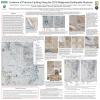Poster #010, Earthquake Geology
New Perspectives on Newport-Inglewood Fault Geometry
Poster Image:

Poster Presentation
2020 SCEC Annual Meeting, Poster #010, SCEC Contribution #10610 VIEW PDF
graphic controls from decades of oil industry well records, and hypocenter and focal mechanism catalogs recently expanded through template-matching (Yang et al., 2012, Ross et al., 2019). We generate 3D fault geometry via an objective and reproducible method that treats these data as weighted interpolation constraints. Our initial 3D fault models highlight the complexity of the fault geometry, which includes multiple splays and complex linkage patterns at depth. Some portions of this fault system appear to reactivate Miocene-age normal faults, which have been rotated into near-vertical geometries that are conducive to strike-slip motion in the present transpressional regime. Overall, these models show similar levels of complexity to recent strike-slip earthquake ruptures (e.g., the 2019 M6.4 and M7.1 Ridgecrest sequence, Plesch et al., 2020), which has important implications for seismic hazard assessment.
SHOW MORE
SHOW MORE




































